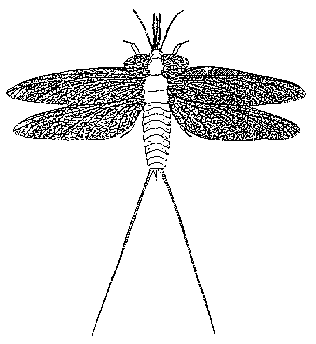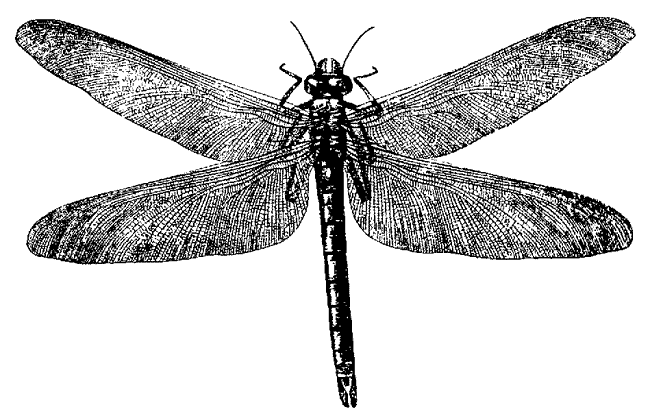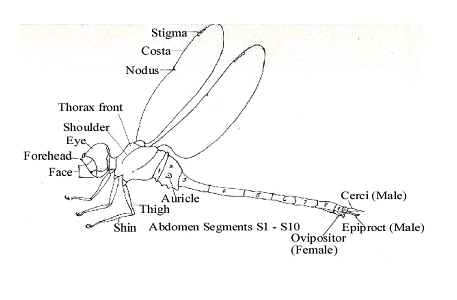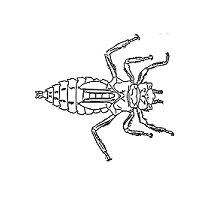|

Tachopetryx thoreyi belong to the class
Insecta. Insecta bodies have three segments. They have three pair of legs that are attached to the middle segment (thorax).
Usually they have two pair of wings. They have large compound eyes, usually three ocelli (median) eyes, and antennae. They
have a digestive system, and breathe through tracheae or gills. Fertilization is internal for most. Also, the female have
a storage area where they can store sperm and use this to fertilize multiple batches of eggs. Most insects are in a different
form when they are young. They either go through complete metamorphosis, or hemimetabolous (partial metamorphosis). The class
Insecta has more organisms that any other life form. Insect fossils have been discovered from the Devonian period, about
400 million years ago. (Campbell et al., 1999, p.618) During the Carboniferous and Permian (248 – 280 million years
ago) periods, insects developed the ability to fly. Insects diversified rapidly after this. Insects are found in every
type of environment on Earth. During the Carboniferous period, insects developed mouths specifically designed to feed on plants
that grew at that time. (Campbell et al., p.619) The wings of insects developed from the outer skin of the insect, rather
than from legs. This meant they still had limbs to grasp with, as well as to walk on. One of the first insects to evolve flight
was the dragonfly (common name for order Odonata). The oldest fossils found of the order Odonata are those of Protodonata,
which are 325 million years old (Pennsylvanian Period).

Meganuera
monyi Brongniart wingspan 75 cm Stephanian Epoch (Upper Productive Coal Measures) - Gzelian epoch Commentry (Allier), France
family Meganeuridae - Bashkirian to Kazanian (early Late Permian) graphic from Karl Von Zittel's Text-Book
of Paleontology ed. Charles R. Eastman, 2nd ed. vol.1 1937 MacMillan & Co. London, p.809, fig.1567 http://www.palaeos.com/Invertebrates/Arthropods/Insecta/Protodonata.html
There is disagreement as
to the relationship of the many suborders of living odonata. The debate revolves around the question as to whether Anisozygoptera
and Anisoptera evolved from Zygoptera, or Zygoptera and Anisoptera evolved from Anisozygoptera. The general consensus
is:
* “Odonata is
a monophyletic group which has been separated from Ephemeroptera, Neoptera, and the extinct Palaeodictyopteroidea since at
least the lowermost Upper Carboniferous
* The three extant
suborders are closely related
* Fossil suborder
Archizygoptera is a subset of fossil suborder Protozygoptera * Modern Anisoptera is monophyletic.” (Trueman & Rowe, 2001)
|
The following
diagrams show the two current phylogeny theories. (Trueman & Rowe, 2001).
Tillyard
(1928) and Fraser (1957)
============================= Protodonata
|
| ========================== Protanisoptera
=====| |
| | ======================= Protozygoptera
===| |
===| ============ Zygoptera (Coenagrionoidea)
| |
=Zygoptera=| ========= Zygoptera (Lestoidea, Calopterygoidea)
| |
===| ====== Anisozygoptera (eg, Epiophlebia)
===|
| === Anisozygoptera (eg,
Heterophlebia)
===|
=== Anisoptera
Handlirsch
(1906-08)
================================== Protodonata
|
| =============================== Protanisoptera
=====| |
| | ============================ Protozygoptera
===| |
===| |======== Zygoptera
| |
==Anisozygoptera===| ====== Anisozygoptera (eg, Epiophlebia)
| |
===| === Anisozygoptera
(eg, Heterophlebia)
===|
===
Anisoptera
|
|
|
|
|
|
Identification
of species is determined by the pattern of wing veins, distance between eyes, shape and position of tail appendages, and whether
or not there is an ovipositor. The larvae are classified by appearance of its’ mouth, how it breathes, body spine pattern
and shape of abdomen.

Anisoptera anatomy redrawn by me from multiple anatomy diagrams.
The suborder Anisoptera has developed an enlarged rectal
chamber with gills. They use this to take in extra oxygen, both on land and under water. It is believed they can also use
the enlarged rectal chamber for “jet propulsion”. (Dunkle, 1981, p. 197) Tachopteryx thoreyi belong to the
Petaluradae family. This family is characterized by eyes set wide apart, an ovipositor containing blades, and “long
parallel-sided stigmas” on the wings. (Dunkle, p.31)The cerci of the male are large and flat, resembling a flower petal

The Petaluradae
family larvae have sturdy enough legs to walk on land.
They live
in a partly wooded environment. These larvae resemble the flat shape of leaves and can cling closely. Prey must crawl
around the larvae, and are more easily captured. Because of this characteristic, is believed the petaluridae family
has lived in deciduous forests for a long time. Adult Petaluradae also exhibit characteristics which suggest they have inhabited
deciduous forests a long time. The flight season,when adults emerge, starts prior to the leaves coming out on the trees. This
makes more sunny areas on the tree trunks, which the males typically perch on, while waiting for females. This behavior also
helps to keep them warm during early spring weather. It is also believed that timing mating before trees are leafed out, makes
it easier for females to find seeps, where they need to lay their eggs. (Seeps are where water trickles out of a hillside
in a forest). (Dunkle, p.198)
|

